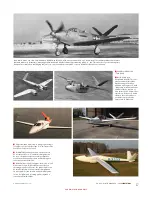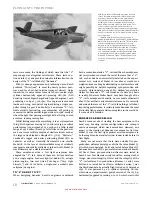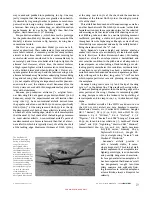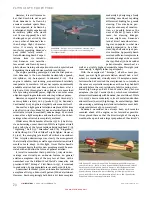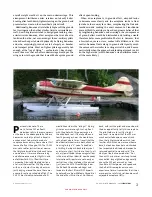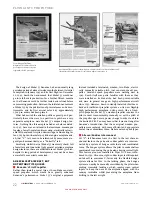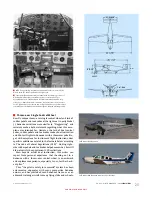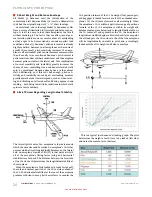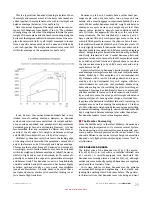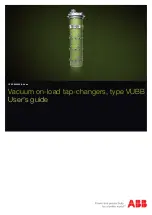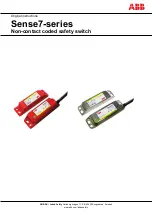
10
A2A
SIMULATIONS :::
ACCU-SIM V35B BONANZA
FLYING INTO THE FUTURE
FOR SIMULATION USE ONLY
■
Ryan (originally North American L- 145 ) Navion B Super 260 C-
FCTI. It is not merely a coincidence that airframe of this excellent
four- seat aeroplane is reminiscent of P- 51 “Mustang” upon
which its design was based. Introduced in 1948, the retractable
tricycle undercarriage Navion is powerful and fast. 260 hp
Navion variants have a useful load of 920 lbs, a top airspeed of
175 mph, can carry four passengers in comfort over a range of
595 miles, take- off in 400 feet and land in 466 feet. Navion was
Bonanza’s closest rival in the late 1940’s and during the 1950s,
outperforming Bonanza in many ways. Celebrities Veronica
Lake, Arthur Godfrey, Mickey Rooney and Bill Cullen were among
those who owned and flew Navions. Many are still flying and
whilst offering something of an awkward climb to enter they are
considered to be a great bargain on the used aeroplane market.
Photo by Barry Griffiths.
■
Piper Pa- 22 “Tri- Pacer.” Introduced in February 1951, this
comfortable four- seat aeroplane is essentially a Piper PA- 20
“Pacer” with a nose wheel. Although rather a throwback with
its fabric- covered aluminium frame and stodgy appearance
(derisively nicknamed “Flying Milk Stool,”) 160 hp versions of
this fine aeroplane give it useful load of 890 lbs, a top airspeed of
141 mph, an 800 fpm climb rate and a range of 650 miles, all with
four 170 lb passengers on board. This writer has enjoyed many
pleasant hours flying Tri- Pacers as well as its two- seat version,
PA- 22- 108 “Colt.” Tri- Pacer was introduced six years ahead
of its chief tricycle- undercarriage rival, the all- metal Cessna
172. As good as Tri- Pacer was and is, it has never been serious
competition for Bonanza. A John Marco photograph
fabric-
covered “Staggerwing” bi-
plane as it had before
the war. As it was, Beech produced 16 variants of Model 17
“Staggerwing” for the USAAF, the USN/USMC and for fifteen
foreign air forces. However, it was Beech’s mass production
of the sophisticated Model 18 “Twin Beech” which consid-
erably informed the company regarding modern metal con-
struction methods and gave it otherwise unobtainable and
invaluable experience regarding the construction and pro-
duction of complex all- metal aircraft. This precious experi-
ence gave Beech a great advantage over virtually all of the
other U. S. light aircraft manufacturers when it conceived
and designed Model 35 “Bonanza” in 1944.
Whilst Model 18 was a great success, the production of
which continued until 1970 with more than 9,000 ultimately
produced, Walter Beech and his staff had been optimisti-
cally looking toward the post- war civilian aviation world
to come. The plan they developed was to produce a high-
performance, luxury, all-
metal, four seat, single-
engine
light executive aeroplane that would be relatively simple
and efficient to operate.
Except for Cessna’s AT-
“Crane” primarily wooden “Bamboo Bomber” bomber
trainers during the war, the other light aeroplane manu-
facturers primarily produced only slightly modified military
versions of what they had been producing before, i.e., light,
low-
powered, two-
seat, “low and slow” fabric-
covered
aeroplanes.
Piper produced O- 59/L- 4, the military version of its
“Cub” and few glider trainers. Stinson produced a military
version of its 105 “Voyager’ designated L- 5 “Sentinel,” a
military version of its pre- war SR- 10 “Reliant,” designated
UC- 81, as well as Model 74/L- 1 “Vigilant,” a larger, more
powerful light observation aeroplane. Aeronca produced a
military version of its tandem- seat trainer, “Champ.” des-
ignated O- 58/L- 3 “Defender” and like Piper, a number of
glider trainers. Taylorcraft produce a military version of its
Model D, designated O- 57/L- 2.
After the war these manufacturers made few if any modi-
fications to their aeroplanes and those which simply were
essentially their early 1940s designs were put back onto
the market. Photographs on Page 9 show some of Beech’s
“competition” were offering in the post- war, late 1940s:
Of course, more powerful and sophisticated aeroplanes
such as Cessna 190/195 (see further discussion of this aero-
plane below,) Ryan Navion, Piper Tri- Pacer, Cessna 172
and Bellanca 14- 19 would soon be produced; however, until
Piper’s 1958 PA- 24 “Comanche 250,” nothing came close
to ousting Bonanza from its position at the top of the heap.
“I SEE A NEW SUN UP IN A NEW SKY”
2
It is an oft- told tale that by the end of W.W. II, U. S. light
aeroplane manufacturers, all of whom had been forced to
curtail their usual retail businesses during the war to supply
aircraft for the armed services, looked forward with anxious
hearts and open coffers to the soon- to- come peace during
which they hoped and believed that the tens of thousands
of returning military pilots, having experienced the “joy”
3
of flight, would wish to continue the same and would gladly
purchase low- priced, simple aeroplanes by the bushel- full.
The Serviceman’s Readjustment Act of 1944, popularly
Summary of Contents for BONANZA ACCU-SIM V35B
Page 1: ...A2ASIMULATIONS BONANZA ACCU SIM V35B BONANZA ...
Page 3: ...A2ASIMULATIONS BONANZA ACCU SIM V35B BONANZA ...
Page 5: ...www a2asimulations com ACCU SIM V35B BONANZA A2ASIMULATIONS 5 FOR SIMULATION USE ONLY ...
Page 27: ...www a2asimulations com ACCU SIM V35B BONANZA A2ASIMULATIONS 27 FOR SIMULATION USE ONLY ...
Page 58: ......
Page 68: ...68 A2ASIMULATIONS ACCU SIM V35B BONANZA www a2asimulations com FOR SIMULATION USE ONLY ...
Page 112: ......

















